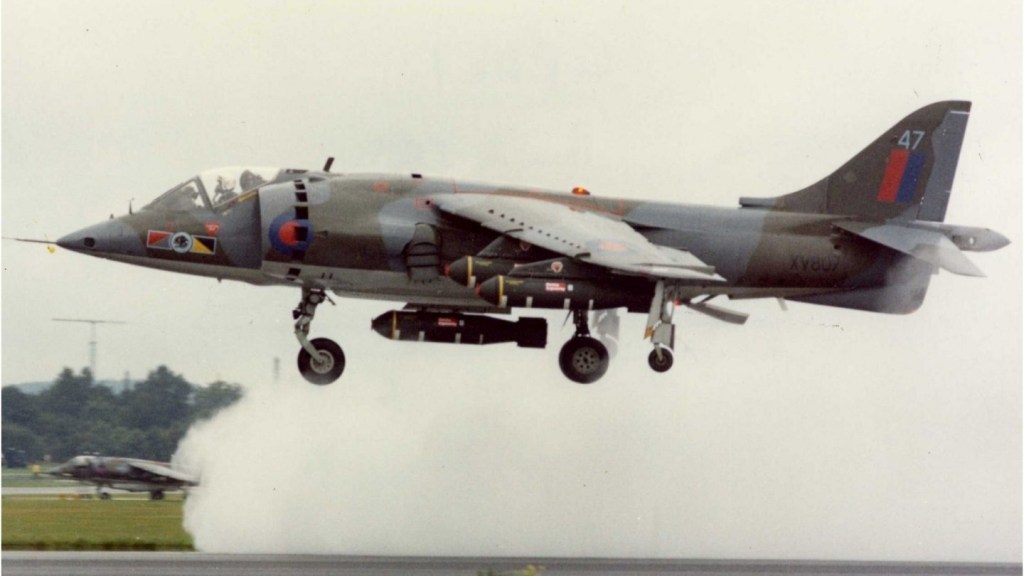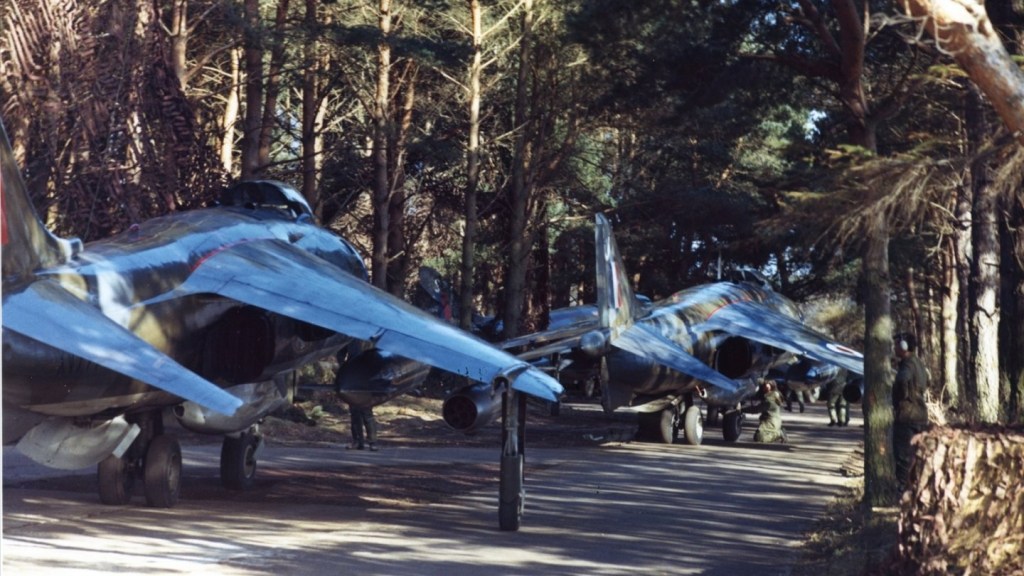We don’t need no edgy ejection: Interview with man who ejected from a Harrier and played on a Pink Floyd album

| Neal Wharton was the first pilot to eject from a Harrier, a Red Arrow and the only RAF pilot credited for providing jet noise on a Pink Floyd album. Hush-Kit met him to find out more. |
What were your first impressions of the Harrier? “Amazing, amazing and amazing.”
What was your most memorable Harrier mission…what happened? “An 8hr 25min non-stop flight from RAF Wittering (Cambridgeshire) to Downsview Airport (Toronto) in 1972, for the Canadian International Air Tattoo. Some RAF high-ranker got a bit drunk at a Canadian embassy cocktail party and boasted that he would arrange for two Harriers to take part in this event. It resulted in highly complex planning involving two Harriers supported by three Victor tankers from RAF Marham in Norfolk and two from Gander in Canada to see us into the final stage of the flight. At the time, I was display pilot on No 1 (F) Squadron and was given pretty much carte blanche to present a two-ship display off Lake Shore Boulevard in Toronto. I actually got clearance to do a wheels-up hovering manoeuvre during the display over water (Lake Ontario). This was not generally permitted over land (because a loss of power might still lead to a survivable crash landing whereas over water it would be a straightforward ejection option) but it looked great, particularly when followed by an impressive climbing acceleration with the other Harrier coming in from the opposite direction very low and very fast. The display went down very well and was witnessed by a crowd of over 300,000.

Describe the Harrier in three words: “Outstanding British development.”
What were the best and worst things about the Harrier? “Best thing: Versatility and a joy to fly. Worst thing: A tendency to roll uncontrollably and crash if travelling near the ground at low speed with excessive side-slip. Something to do with intake momentum drag!”
What do you remember of your ejection and the flight which led to it? “I remember my ejection experience as clearly now as when it happened just over 50 years ago (October 1970). This was in the early days of the Harrier and we were operating out of RAF Ouston, a disused World War II airfield near Newcastle, practicing for off-base deployments. I took off, leading a pair of aircraft to carry out a live weapons sortie at Tain Range on the Dornoch Firth in Scotland. We were armed with 28lb practice bombs and 30-mm cannon. The sortie was going normally and after completing our mission we left the range to return to Ouston. I radioed the tower as we approached and they cleared us to make an approach for a conventional landing on the runway. As I was leading, I carried out a circuit at around 1000 ft with my wing man a short distance behind me (he had a good view of the whole thing). I turned onto finals and commenced my approach. At this stage my speed would have been around 170 knots and I would have lowered the landing gear, deployed some flap and rotated the nozzles to reduce speed. As I descended through about 700 ft the engine, without warning, suddenly shut down (or ‘flamed out’ as we would have called it). My initial instinct was to check my fuel state (it wouldn’t have helped but that might have been one explanation for the sudden loss of power) at the same time I operated the relight button on the throttle. The aircraft was now descending more rapidly and I made a quick radio call:
‘Mayday, Mayday, I’ve flamed out, I may have to eject’.
I was still desperately trying to relight the engine to no avail and I was now descending very fast (the Harrier has the gliding performance of a brick, as we used to say) and I can remember very clearly that the trees I was going towards were rapidly getting bigger; I was certain I’d left it too late but I grabbed the ejection seat handle and pulled … “

The Harrier has a rocket assisted ejection seat which when activated fires the seat (plus pilot) out of the aircraft with an explosive charge and a split second later the rocket ignites, firing the seat up to a height of 400 feet in less than half a second. Just before the seat leaves the aircraft, a small strip of plastic explosive shatters the cockpit perspex canopy rather than the seat breaking through a solid canopy, which used to happen. I was fortunate in that the aircraft I was flying was almost brand new and was one of only two on the Squadron which had this device.”
Want to see more stories like this: Follow my vapour trail on Twitter: @Hush_kit

Preorder your copy today here.
The solid well-researched information about aeroplanes is brilliantly combined with an irreverent attitude and real insight into the dangerous romantic world of combat aircraft.
The book will be a stunning object: an essential addition to the library of anyone with even a passing interest in the high-flying world of warplanes, and featuring first-rate photography and a wealth of new world-class illustrations.
Sadly, this site will pause operations if it does not hit its funding targets. If you’ve enjoyed an article you can donate here and keep this aviation site going. Many thanks

“. . . . my immediate memory on pulling the handle was a huge kick in the backside as the seat was banged out of the aircraft. At the same time I was aware of going up through something like confetti, but which was, in fact, hundreds of pieces of perspex as the canopy exploded. I was now aware of tumbling through the air until suddenly it stopped, as the drogue chute deployed to stabilise the seat before pulling out the main parachute. At this stage I remember looking upwards (which was in fact downwards as I was now inverted) and saw a huge swathe of orange fire as the Harrier struck the ground. (I had been in that aeroplane approximately one second earlier!) I didn’t bother to look up and check whether the parachute had deployed properly (as most people tend to do) because I suddenly realised that I was going to survive, which is a feeling quite difficult to describe. I didn’t have long in the chute but I managed to unclip and lower my personal survival pack (PSP) which contains, among other things, your dinghy – useful if ejecting over water. I hit the ground hard, going backwards and with a wind gusting to 30knots… the sort of conditions which might well have caused a broken leg but not if you were as relaxed as me – I was alive!
I lay on the ground, cautiously examining arms and legs to see if they were still there and was pleased to see that all seemed well and that the chute had collapsed on landing rather than dragging me along the ground in the strong wind. I stood up, unbuckled myself from the chute, and surveyed the scene. I was in a large grassy field with my aircraft blazing furiously a hundred feet or so away, belching out black smoke into the autumn sky. The metal skin round the cockpit was white hot. A lady, the farmer’s wife I discovered later, was cautiously approaching. Her face was ashen and she was very shaken. As she got close to where I was standing she managed to ask, in a quavering voice, ‘Would you like a cup of tea?”
Epilogue:
The engine failure was found to have been due to a worn bearing in the engine driven gear box which powered the main fuel pump. I ejected at about 100ft and the aircraft hit the ground 1.1 seconds later. I received minor neck injuries due to whiplash during the initial part of the ejection sequence but I was flying again two weeks later. I never did get that cup of tea but I did sink quite a few beers with the guys when I got back from the hospital!”
What was your collaboration with Pink Floyd? “Yes, that was me on their album ‘The Final Cut’. It referred to some sound effects that I helped with, using a Hawk and a very low pass at 480 kts!”
Special thanks to Phil Rowles & Martin Baker

I did crash guard on this aircraft at Stamfordham